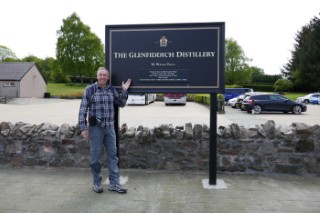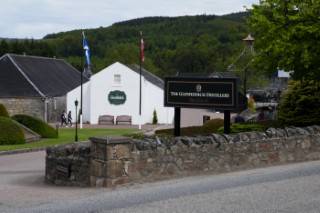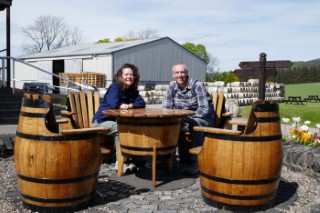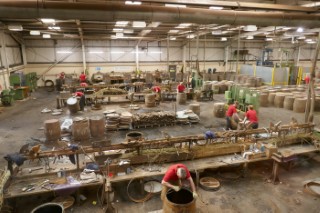|
Scotch Whisky |
|
I wanted to provide a little information on Scotch. My knowledge of Scotch is extremely limited, so I would suggest searching the internet for additional information. I have included some of the basics here that I found on other websites and with Google AI results as well as my own experience.
It was not until 2019 that we finally took a trip to Scotland. Although we lived in England for 3 years, for some reason, we never made it to Scotland. As we were going to Scotland, we wanted to learn a little about Scotch prior to our trip.
My first Scotch experience
Years ago, a friend of mine had a sampler pack of small bottles of different types of Scotch. This was a long time ago and neither of us had any idea of how to drink it. We tried them all ‘neat’ and I remember thinking they went from bad to worse. It wasn’t until about 30 years later that I decided to give it another try.
Scotland trip
Before our trip to Scotland, we decided to learn a little about Scotch and how to drink it. So, we did some internet research and watched some travel shows explaining different ways to sample it.
We went to a liquor store and bought a small bottle of 15-year-old Glenfiddich Scotch. We picked Glenfiddich as we planned to stop there on our trip. We started with a sip ‘neat’ (no water or ice added). After that, we added a few drops of water and retasted. We continued to add a little more water until the harshness went away, and we could actually enjoy it. As we added different amounts of water, not only did it become more drinkable, but the smell and taste would change. The bottom line is, how you like do drink it is entirely up to you. Experiment with it by adding very small amounts of water until you get to a point where you can enjoy it. You will also find that different Scotches will be completely different and the amount of water you add to one may be entirely different for another.
|
Visiting the Glenfiddich Distillery in Scotland |
 |
 |
We recently moved to a new area and several of our neighbors are Scotch drinkers. I have learned from them and have sampled several of their nicer bottles.
For me, I’m happy with something like the Johnny Walker Red Label which is not as expensive as others. I find it has a nice flavor and depending on the added water, it can have a slight sweet taste and slightly smoky.
There are countless Scotches, but I want to mention Ardbeg, another one I have tried. This is a more expensive Scotch with a smokiness that will knock your socks off. With it’s extreme smokiness and strong flavor, it’s one of those Scotches you bring out later in the evening after you have been drinking other milder ones. It’s so smoky that just by taking the lid off, you’ll think you’re sitting by a campfire.
Just down the road from Glenfiddich is the Speyside Cooperage, home to the ancient art of Coopering since 1947.
The cooperage still uses many traditional methods for shaping, shaving and charring casks for what is an integral part of the whisky industry. Each year, it produces and repairs nearly 150,000 oak casks used by the surrounding Speyside Whisky distilleries, as well as distilleries throughout Scotland and the rest of the world.
|
Speyside Cooperage |
 |
 |
Now about Scotch
Scotch, or Scotch whisky, is a distilled spirit made in Scotland using malted barley (or other grains), water, and yeast. It must be produced and matured in Scotland for at least three years in oak barrels and bottled at a minimum of 40% ABV. Scotch whisky is known for its diverse flavor profiles, ranging from smoky and peaty to fruity and elegant, depending on the region and production methods.
ABV stands for Alcohol by Volume, and it's a standard way to measure the alcohol content in alcoholic beverages. It indicates the percentage of the total volume of a drink that is pure alcohol (ethanol).
For example, a beer with 5% ABV means that 5% of the beer's volume is alcohol, while the remaining 95% is other components like water, flavorings, etc.
The main difference between Scotch and whiskey lies in their origin and production. All Scotch is whisky, but not all whisky is Scotch. Scotch whisky must be produced and bottled in Scotland.
The following information was taken from Google AI search results or from the MyNameIsWhisky website:
https://www.mynameiswhisky.com
https://www.mynameiswhisky.com/scotch-whisky-101-a-comprehensive-guide-to-the-worlds-favorite-spirit
Scotch Whisky Regions
As we mentioned, the whisky profile also varies depending on the region of whisky production. We will return to this topic further in the future to explore each of the regions in more detail. For the moment, as this article aims to be a basic guide to Scotch whisky, we will just briefly describe the regions’ characteristics.
Scotch Whisky is produced all over Scotland and can be broken down into six regions.
Highlands
The Highlands region is the largest producer of whisky, which is why the whisky produced in this area is diverse and offers a wide range of flavors. As a result, it is difficult to categorize the specific style of whisky that comes from this region. Hence, generally, the whiskies from this area are divided into four subregions:
-North: the whiskies are full-bodied, sweet & rich in character
-East: the whiskies are lighter and fruity
-South: the whiskies are light and fruity with a touch less body compared to the whiskies from the east
-West: the whiskies are full-body with a peaty punch
Speyside
The region of Speyside is located in the northeast of Scotland surrounding the River Spey.
Speyside is renowned for its extensive variety of whiskies, which exhibit different characteristics, particularly known for their sweet single malts that contain little or no peat. This style of whisky makes Speyside an ideal starting point for beginners who are embarking on their whisky journey.
Lowlands
The Lowlands region extends from the south of Scotland up to the north of Glasgow and Edinburgh.
Lowland whiskies are distinct from other regions in that they tend to be light and gentle with no peatiness. Since the distilleries are located inland, there is a slight salinity within the whisky. As a result, Lowland whiskies are an excellent introduction to malt whisky.
Campbeltown
Campbeltown Whisky is recognized for its dry and sometimes pungent taste, which is attributed to its location. As the region protrudes from the mainland and is closer to the neighboring islands of Arran and Islay than any other mainland producer, it has developed its unique flavor.
Islay
The Scottish Island of Islay (pronounced eye-luh) is located to the west of the mainland. The region is known for its peaty single malts. Because these whiskies can be a bit overpowering, we recommend them to those who are already familiar with the world of whisky.
Islands
Whisky produced on the islands surrounding the mainland of Scotland offers a diverse and unique taste, although they are not officially recognized by the Scotch Whisky Association. They are often grouped together geographically as they are all islands.
All whiskies from the Islands have diverse flavors, but common elements include peat and salinity, the latter being due to their proximity to the sea.
Flavor Profiles
Scotch whisky is renowned for its complex and varied flavors, which are influenced by a range of factors, including the location of the distillery, the water source used, and the type of cask used for maturation. Here are some of the key flavor profiles you may encounter in Scotch whisky:
Smoky/Peaty: Whiskies that have been produced in areas of Scotland where peat is commonly used as a fuel source often have a smoky, peaty flavor. This flavor is derived from the smoke that is produced when the peat is burned during the drying process.
Fruity: Some whiskies have a fruity flavor profile, with notes of apple, pear, or citrus.
Floral: Other whiskies have a floral flavor profile, with notes of heather or honey.
Spicy: Some whiskies have a spicy flavor profile, with notes of cinnamon, nutmeg, or ginger.
Sweet: Many whiskies have a sweet flavor profile, with notes of vanilla, toffee, or caramel.
Serving Suggestions
Scotch whisky can be enjoyed in a variety of ways, depending on personal preference and the type of whisky being consumed. So don’t be afraid to experiment!
Neat: Many whisky connoisseurs prefer to drink their whisky neat, or without any mixers. This allows them to appreciate the full range of flavours and aromas in the whisky.
With Water: Adding a few drops of water to your whisky can help to open up the flavours and aromas, making them more pronounced.
On the Rocks: Some people prefer to drink their whisky on the rocks, or with ice. This can help to mellow out the flavours and make the whisky more refreshing on a hot day.
With Cocktails: While purists may frown upon mixing their whisky with anything else, some people enjoy their whiskies in cocktails, in combination with soda, ginger ale, or fruit juice to create a refreshing drink.
Types of Scotch Whisky
Single Malt Scotch Whisky: Made from 100% malted barley at a single distillery, typically using pot stills.
Single Grain Scotch Whisky: Made at a single distillery but can include other grains like wheat or corn alongside malted barley.
Blended Scotch Whisky: A blend of single malt and single grain whiskies from different distilleries.
Blended Malt Scotch Whisky: A blend of single malt whiskies from different distilleries.
Blended Grain Scotch Whisky: A blend of single grain whiskies from different distilleries.
Cask Maturation
The type of oak cask used for aging (American or European) significantly impacts the flavor, with American oak contributing vanilla and caramel notes, and European oak adding richer, fruiter notes.
Malting
Peated Scotch whisky starts with malted barley, where the barley is germinated and then dried.
(Malt is a barley or other grain that has been steeped, germinated, and dried, used for brewing or distilling and vinegar-making)
More on Peat Smoke
Peat smoke in Scotch whisky is imparted during the malting process when malted barley is dried over a peat fire. The peat smoke, often called "reek" in the industry, infuses the grains with smoky, earthy, and sometimes medicinal flavors. The intensity of the smoky flavor depends on the length and intensity of the peat smoke exposure, as well as the characteristics of the peat itself. Historically, peat was the primary fuel source for drying barley, leading to a strong tradition of peated whisky in Scotland, particularly in regions like Islay.
Peat Fire
To dry the malted barley, distillers traditionally use peat fires, which release aromatic compounds into the barley.
Flavor Profile
The smoke from the peat imparts a distinct smoky, earthy, and sometimes medicinal flavor to the whisky.
Intensity Varies
The level of smokiness in a whisky can vary significantly, depending on the amount and type of peat used, as well as the duration of the drying process.
Historical Significance
Peat was historically the most readily available fuel source in many parts of Scotland, leading to the widespread production of peated whisky.
Modern Usage
While other fuel sources are now available, many distilleries continue to use peat to create the distinctive smoky character of certain Scotch whiskies.
|
|
|
|
|